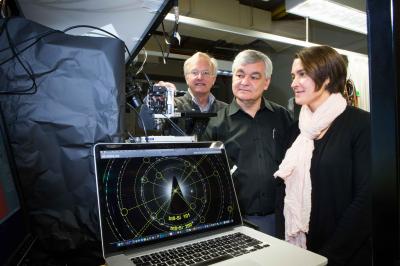Silicon micro-explosions for better superconductors
Laser-induced micro-explosions in the common computer chip material, silicon, could lead to simple processes for developing superconductors and high-efficiency solar cells and light sensors. A team of scientists from Australian National University has been studying their micro-explosions for a year.
There’s a ton of tinkering that can be done with lasers. Now scientists are using lasers to create better superconductors and solar cells.
Scientists from Australia National University have made some headway in this department. A team of researchers created laser-induced micro-explosions in silicon, the common computer chip material.

Professor Jim Williams, Professor Andrei Rode and Associate Professor Jodie Bradbury with the complex electron diffraction patterns. (Image credit: Stuart Hay, ANU)
What does that mean?
The micro-explosions could lead to a simple process for developing superconductors or high-efficiency solar cells and light sensors, according to Professor Andrei Rode, from The Australian National University (ANU).
“We’ve created two entirely new crystal arrangements, or phases, in silicon and seen indications of potentially four more,” said Professor Rode, a laser physicist at the ANU Research School of Physics and Engineering (RSPE).
The team directed the lasers onto silicon that was buried under a clear layer of silicon dioxide in order to reliably blast tiny cavities in the solid silicon. This process created high pressure around the explosion site and formed the new phases with complex structures. The team of physicists from ANU and University College London actually took an entire year to study and understand the phases of these structures and their implications.
They used electron diffraction patterns and structure predictions and discovered that the new materials have crystal structures that repeat every 12, 16 or 32 atoms respectively, according to Professor Jim Williams, from the Electronic Material Engineering group at RSPE.
The laser micro-explosions changed the simple silicon material into something much more complex which then opened up the possibility for unusual and unexpected properties.
The silicon’s new phases are often unstable, but the small size of the structures means the materials cool very quickly and solidify before they can decay, said Professor Eugene Gamaly from the ANU Research School of Physics and Engineering.
The new crystal structures that the scientists created have survived for more than a year now enabling a better understanding of how lasers actually work with solid objects.
Traditionally when scientists use high pressure to create materials, they use tiny diamond anvils to poke around, but by using the ultra-short laser micro-explosions, they were able to create pressure that was much higher than the strength of the pressure a diamond crystal can produce.
Future applications
The team’s new findings could mean much cheaper and industrially-friendly method for large scale manufacturing of these exotic materials, according to Dr. Jodie Bradby, also from ANU Research School of Physics and Engineering.
“We reliably create thousands of micron-size modified zones in normal silicon within a second,” said Bradby.
Since semiconductors make up a billion dollar industry a change as small as a micro-explosion that re-positions some silicon could have a major impact on the future of materials.


